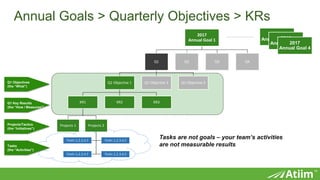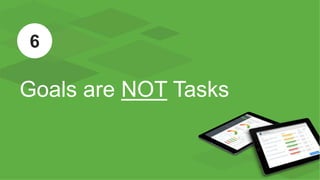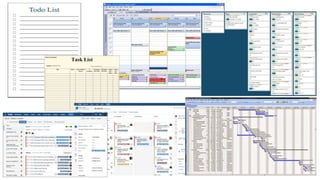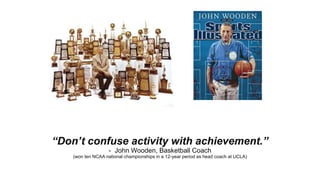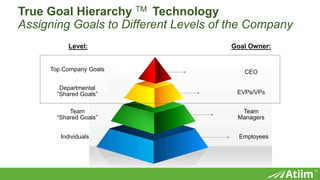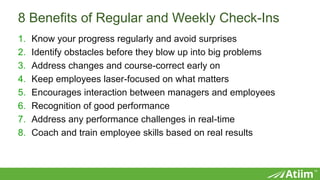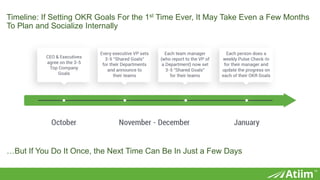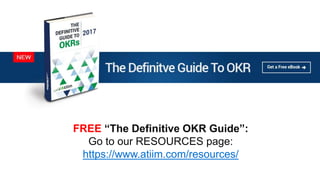14 Tips for Using OKR Goals
- 1. ™ Easily set clear business objectives, align your teams, focus everyone on what matters, track progress, and drive great results.
- 2. ™ NEW 2017-2018 Expert Series 14 Tried & True Tips for Using OKR Goals (Pronounced: A-Team) for OKR Goals & Ongoing Performance Management#1
- 4. ™ OKRs is a critical thinking framework and ongoing discipline that seeks to ensure employees work together, focusing their efforts to make measurable contributions that drive the company forward. Source: Objectives & Key Results,Paul R. Nivenand BenLamorte
- 5. ™ ™ Clear objectives align everyone at your company and focus collective effort on what really matters so that you can achieve your top corporate goals.
- 6. ™ OKR Definitions • Objectives (Os) - Answers : WHAT we want to accomplish - A qualitative title or a headline - A “Strategic Theme” - Worded to focus on results/outcomes, not activities or tasks • Key Results (KRs) - Answers: How will we accomplish the Objective? - A Key Result is either a Milestone or a quantified Metric - Author it as a typical measurable objective or MBO - KRs help you measure the Objective’s progress - They are the lowest level of detail and don’t break down any further
- 7. ™ We Want to: {Objective} as measured by this set of KRs: {1. Key Result} {2. Key Result} {3. Key Result}
- 9. ™ Writing OKRs - The Importance of Language • Try to word an Objective (i.e. the title/headline) that inspires the team to reach high and tap into their best performance • Use action verbs to start Objectives or KRs • Phrase the OKRs in the language relevant to the target group
- 10. ™ Set Them Quarterly, Not Annually or Monthly 3
- 11. ™ Annual Goals > Quarterly Objectives > KRs 2017 Annual Goal 1 Q1 Q1 Objective 1 KR1 Projects 1 Projects 2 Tasks 1,2,3,4,5 Tasks 1,2,3,4,5 Tasks 1,2,3,4,5 Tasks 1,2,3,4,5 KR2 KR3 Q1 Objective 2 Q1 Objective 3 Q2 Q3 Q4 2016 Annual Goal 22016 Annual Goal 32017 Annual Goal 4 Q1 Objectives (the “What”) Q1 Key Results (the “How / Measures”) Projects/Tactics (the “Initiatives”) Tasks (the “Activities”) Tasks are not goals – your team’s activities are not measurable results
- 12. ™ Break Down Strategy Into Clear Goals 4
- 13. ™ Translate yourbusiness strategy into a few, clear and focused goals. These goals will connect yourteam’s execution back to your strategy.
- 14. ™ Use These 5 Criteria 5
- 15. ™
- 16. ™ Goals are NOT Tasks 6
- 17. ™ “Never mistake activity for results.” - Lou Gerstner, former CEO of IBM and RJR Nabisco (Credited with turning around IBM’s fortunes) Image Source: Forbes
- 18. ™ Task vs. Project vs. Goals • A task (a “to do”) is something that you do (i.e. tasks are just “activity”) • A project is an initiative – to complete your project, you have to do various tasks • A goal is the OUTCOME or RESULT that you need to achieve. You usually have to complete a combination of projects in order to attain your goal.
- 19. ™
- 20. ™ “Don’t confuse activity with achievement.” - John Wooden, Basketball Coach (won ten NCAA national championships in a 12-year period as head coach at UCLA)
- 21. ™ How To Cascade & Align the Goals 7
- 22. ™ True Goal Hierarchy TM Technology Assigning Goals to Different Levels of the Company Top Company Goals Team “Shared Goals” Individuals Level: Departmental “Shared Goals” CEO EVPs/VPs Employees Goal Owner: Team Managers
- 23. ™ Top Company Goal: Business Unit / Department Goal: Team Goal: Individual Goal: Key Result 1 Key Result 2 Key Result 3 Example: How You Would Cascade Goals
- 24. ™ Top Company Goal: Division / Department Goal: Team Goal: Individual Goal: Key Result 1 Key Result 2 Key Result 3
- 25. ™
- 26. ™
- 27. ™ How Many is Too Many 8
- 28. ™ Goal Planning • Objectives -Limit ideally to only 1 to 3 Objectives (maximum of 5) 1-3 per Company 1-3 Department/Team 1-3 per Individual Person • Key Results -1-3 Key Results per Objective
- 29. ™ Focus: We must realize—and act on the realization—that if we try to focus on everything, we focus on nothing. A few extremely well- chosen objectives impart a clear message about what we say “yes” to and what we say “no” to. Source: High Output Management, Andy Grove, p.111
- 30. ™ Start EVERY Team Meeting With Goals 9
- 31. ™ Start With Goals • How is your progress on your top goals? • Do you think you’re on track overall? • What are the small wins you’re proud of?
- 32. ™ Identify Problem Areas Early • Where are you stuck? • What are the bottlenecks where I can help you? • What goals are “At Risk” (in the red)? • How can I help you attain these goals?
- 33. ™ Cross-Functional Alignment & Collaboration • Are teams aligned? • Is there cross-functional collaboration? • Are people commenting on each other’s goal progress, praising goal attainment, nudging the effort, offering feedback?
- 34. ™ 10 The 3 Secrets of Getting Started
- 35. ™ 3 Keys to Success When Starting To Set Goals 1. Discretion 2. Common Sense 3. Walk before you run
- 36. ™ The 1 Critical Must Do Tip 11
- 37. ™ The key is to set and use OKRs frequently.
- 38. ™ Source: APA -http://psycnet.apa.org/?&fa=main.doiLanding&doi=10.1037/bul0000025 2016 A random effects model revealed that, on average, interventions were successful at increasing the frequency of monitoring goal progress … promoted goal attainment... Moderation tests revealed that progress monitoring had larger effects on goal attainment when the outcomes were reported or made public, and when the information was physically recorded. Taken together, the findings suggest that monitoring goal progress is an effective self- regulation strategy, and that interventions that increase the frequency of progress monitoring are likely to promote behavior change.
- 39. ™ You MUST Do Weekly Progress Check-Ins (it’s only 5-10 mins)
- 40. ™ 8 Benefits of Regular and Weekly Check-Ins 1. Know your progress regularly and avoid surprises 2. Identify obstacles before they blow up into big problems 3. Address changes and course-correct early on 4. Keep employees laser-focused on what matters 5. Encourages interaction between managers and employees 6. Recognition of good performance 7. Address any performance challenges in real-time 8. Coach and train employee skills based on real results
- 41. ™ Source: HR Technology Disruptions in 2016,Bersin by Deloitte,Josh Bersin
- 42. ™ Goals are combined with Employee Feedback to increase performance (& Employee Engagement in their work at your company). Source: Gallup – Employees Want a LoreMorefrom theirManagers
- 43. ™ Win With “Small Wins” 12
- 44. ™ Source: Harvard Business Review, Teresa Amabile and Steven Kramer Ongoing Weekly Progress Check-Ins Offer You a Significant Competitive Advantage
- 45. ™ How Long To Plan and Launch? 13
- 46. ™ Timeline: If Setting OKR Goals For the 1st Time Ever, It May Take Even a Few Months To Plan and Socialize Internally …But If You Do It Once, the Next Time Can Be In Just a Few Days
- 48. ™ FREE eBook: Go to our RESOURCES page: https://www.atiim.com/resources/
- 50. ™ Atiim is an enterprise goals and performance management platform that transforms the way organizations and their people align and revolutionizes how companies work to achieve maximum performance and stellar results. Our mission is to make mid-market companies more: aligned, competitive, effective and successful. (Pronounced: A-Team) for OKR Goals & Ongoing Performance Management#1
- 51. ™ FREE OKR Infographic: Go to our RESOURCES page: https://www.atiim.com/resources/
- 52. ™ FREE “The Definitive OKR Guide”: Go to our RESOURCES page: https://www.atiim.com/resources/
- 53. ™ Easily set clear business objectives, align your teams, focus everyone on what matters, track progress, and drive great results.
Editor's Notes
- This is the future
- This is the future
- Everyone needs to summarize the “Tactics” for each KR during the OKR planning process and before OKRs are set in place for next quarter Baseline KRs – if you don’t know the actual metrics
- Where it started
- Big Goals Agility = must transition from once-a-year annual goal setting to quarterly planning to be agile Engagement
- When you ask any employee at a high-performing, well-run company about what are the company’s top goals, they know clearly what they are, and not only that but they know exactly how their own work aligns directly to them (to help achieve the company’s top goals). Atiim helps every company run like that. Atiim is a truly unified and integrated goals & real-time performance management platform for the modern workplace.











